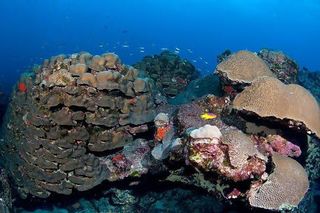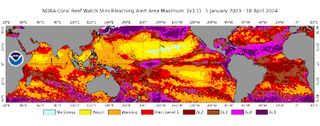Coral Reef Awareness Week took place around the world the week of July 15 to annually highlight the importance of these underwater ecosystems. But given that these structures are essential to both the waters that support them and the land we live on, I would argue that they deserve far more attention than they can get in just seven days, especially in a climate of warming.
Beyond their natural utility, these habitats are also extremely important to the economy. They generate an estimated $9.8 trillion per year globally; in the United States alone, coral reef services in the form of fisheries, tourism, and coastal protection amount to $3.4 billion per year.
On the positive side, thanks to satellitesScientists have been able to better understand these “rainforests of the sea”, which are home to nearly 25% of our planet’s marine life, or more than 4,000 different types of fish.
Coral Reef Awareness Week took place around the world the week of July 15 to annually highlight the importance of these underwater ecosystems. But given that these structures are essential to both the waters that support them and the land we live on, I would argue that they deserve far more attention than they can get in just seven days, especially in a climate of warming.
Related: Beavers help fight climate change, satellite data shows

Beyond their natural utility, these habitats are also extremely important to the economy. They generate an estimated $9.8 trillion per year globally; in the United States alone, coral reef services in the form of fisheries, tourism, and coastal protection amount to $3.4 billion per year.
On the positive side, thanks to satellitesScientists have been able to better understand these “rainforests of the sea”, which are home to nearly 25% of our planet’s marine life, or more than 4,000 different types of fish.
“One of the main challenges before the arrival of satellites was the coverage of the seabed. We needed more on-board technologies, like sonar, to monitor different areas, but the coverage was always uneven,” said Andrea Rivera-Sosa, project and outreach manager for the Global Conservation Science Programme with the Coral Reef Alliancetold Space.com. “Some areas had more resources and maps, while others, less explored, had less coverage. Satellites bring new technologies to increase our coverage with global maps.”
“Using satellites,” Rivera-Sosa continues, “depending on the resolution and the type of image, you can get a general view of the extent of the reef. You can see many parameters, like the watercolor, and then take that image and process it to see the depth and its bathymetry, among other parameters. If the water is green, there is more algae and if it is clear, it has less nutrients. You can also see how cloudy it is, how murky it is, because of suspended particles from rivers and other sources.”

The National Oceanic and Atmospheric Administration (NOAA) has been at the forefront of establishing a network to monitor and study the world’s coral reefs. In 2000, the organization actually created a program called Coral Reef Monitoring (CRW)and over the past 20 years, partnerships have developed between reef managers and researchers using images and data from NOAA satellites, computer models and real data.time observations. Overall, the CRW really helped scientists keep tabs on the health of the reefs as well as the threats these habitats were facing due to pollution, climate change and overfishing.
“We know that coral reefs remain under serious threat from ocean warming in particular, but we also know that reducing coastal pollution and increasing reef fish stocks can help reefs become more resilient in the long term,” Greg Asner, director of the Center for Global Discovery and Conservation Science at Arizona State University, told Space.com. Allen’s Coral Atlas (ACA)“We have excellent tracking of how our satellite data streams are helping people manage and monitor coral reefs around the world.”
“We average about 60,000 users per year and about 600 to 800 dataset downloads per month,” Asner continued. “Our users make decisions using ACA data on marine spatial planning and protection topics, including 35 new marine protected areas and similar designations since 2020. Many of our users also monitor water quality and coral bleaching using ACA, the only near real-time global source for this information.” Earth” . “

Last April, NOAA announced that: for the fourth time in historyA global coral bleaching event is underway. Satellite images and data have provided scientists and researchers with confirmation of the event and where corals have been most stressed by these historically warm ocean waters.
A fleet of watchful eyes of space Satellite imagery can detect large-scale temperature changes, even in remote locations where data has traditionally been difficult to obtain. This is just one example of how satellite imagery is helping to keep the world informed about the impacts associated with climate change, allowing scientists to better understand our planet, identify problems, and drive positive change and adaptation.
“We are all connected to the ocean in some way. Satellites have also allowed us to gather information about the impacts of climate change at a level that we didn’t have before. Satellite data helps us assess sea surface temperatures, sea level rise, bleaching, and can also give us information about ocean acidification,” Rivera-Sosa said. “The oceans help regulate our climate; they absorb all this energy that we humans produce. If we continue to warm our system, our oceans will warm and lose their ability to regulate our climate. We’re seeing massive coral bleaching events and stronger, more intense hurricanes. And that’s impacting us no matter where we live.”